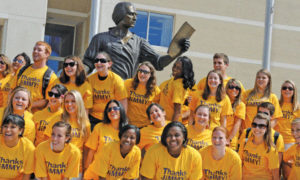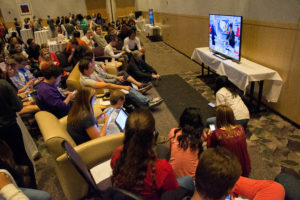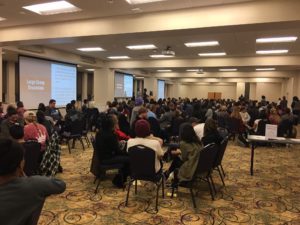Here is a guest post I wrote for the American Democracy Project at the American Association of State Colleges and Universities, July 2017

The James Madison statue on East Campus (“Big Jimmy”) is a popular spot for photographs, especially on Constitution Day. Photo courtesy JMU Marketing and Communications.
We take civic engagement very seriously at James Madison University. Originally founded as the State Normal and Industrial School for Women in 1908, this institution has been renamed and rebranded multiple times. President Samuel Page Duke proposed the name Madison College in 1938 in part to commemorate the legacy of the nation’s so-called “Forgotten Founder,” and President Ronald Carrier led the transformation of that institution into James Madison University in 1977. Since then, the link to our nation’s fourth president, the Father of the Constitution, has become more intentional with every passing decade. And that is very fitting since Mr. Madison was one of the young republic’s most ardent advocates for higher education. “Learned institutions,” he wrote in an 1822 letter, “throw that light over the public mind which is the best security against crafty & dangerous encroachments on the public liberty. . . . What spectacle can be more edifying or more seasonable than that of liberty and learning, each leaning on the other for their mutual and surest support?”
From the moment they first step on campus, students are exposed to Madison’s political legacy. We aren’t subtle! Madison statues, Madison quotes in public spaces, and Madison logos in university publications complement the classical architecture that defines our historic Quad, the symbolic heart of the institution. As part of Orientation in August, all 4,500+ freshmen participate in a program called “1787,” which includes a 75-minute academic exploration of our ethical reasoning framework, the Madison Collaborative. We annually mark Constitution Day, September 17, with cake, pocket Constitutions from our friends at the Robert H. Smith Center for the Constitution, and a free trip to Montpelier, Madison’s home and estate in nearby Orange County.

More than 300 JMU students turned out for a Presidential Election Returns Watch Party on Nov. 8, 2016. Photo courtesy JMU Marketing and Communications.
Two years ago, in tandem with a successful, student-led effort to establish an on-campus precinct, we launched Dukes Vote, a fall voter registration initiative that combines social media posts and mass emails with links to TurboVote, coordinated tabling at locations across campus, and visits to residence halls and general education classes. Students are also encouraged to explore civic tools like icitizen and BallotReady that provide information about issues of special concern and perspectives on candidates running for different offices.
But civic engagement also runs through the curriculum, especially the General Education Program, The Human Community, which is divided into five areas of learning outcomes called clusters. The American Experience area of Cluster Four: Social and Cultural Processes, for example, especially reflects JMU’s long-standing commitment to prepare undergraduates for citizenship. The area came about in 1998 after the Virginia House passed a joint resolution directing the boards of visitors of the sixteen public colleges and universities to review their general education programs to implement a US History requirement. Today, our nearly 19,000 undergraduates choose among three unique, 4-credit courses, either HIST225: US History, POSC225: US Government, or JUST225: Justice Studies. The common outcomes, designed by our own faculty, state that students will be able to identify, conceptualize and evaluate:
- Social and political processes and structures using quantitative and qualitative data
• Key primary sources relating to American history, political institutions and society
• The nature and development of the intellectual concepts that structure American political activity
• The history and operation of American democratic institutions
• The history and development of American society and culture
• The history and development of American involvement in world affairs.

Deliberative dialogue techniques are used in curricular and co-curricular spaces to foster civic competence. Feb. 8, 2017 D.E.E.P Impact event.
To measure performance on these outcomes, we use a 40-item instrument delivered during 1787 (Freshman pre-test) and again on our annual Assessment Day (sophomore post-test) to thousands of students each year. We are proud to have decades of data showing the value-added by a JMU course to our students’ acquisition of essential civic knowledge. Further, JMU is one of only three Virginia campuses that require a course focused on America’s democratic political heritage. Other areas of the general education program support civic learning with outcomes related to ethical reasoning, critical thinking, scientific literacy, and diversity. In fall 2017, we are launching an innovative version of our required general education human communication course for 200 Honors College students. Designed to incorporate constructive advocacy and deliberative dialogue, this course builds on faculty work with the Kettering Foundation and serves as a pilot for revisions that may soon impact all undergraduates.
This summer will see the launch of the James Madison Center for Civic Engagement, which is charged with coordinating and promoting civic engagement university-wide. The new center is part of a bold strategic plan that calls us to be the national model of the engaged university. At JMU, we have purposefully divided engagement into three distinct, yet complementary components that reflect our long-standing institutional culture and values:
- Engaged Learning: Developing deep, purposeful and reflective learning, while uniting campus and community in the pursuit, creation, application and dissemination of knowledge;
- Community Engagement: Fostering mutually beneficial and reciprocal partnerships, ranging from local to global, that connect learning to practice, address critical societal problems and improve quality of life;
- and Civic Engagement: Advancing the legacy of James Madison, the Father of the Constitution, by preparing individuals to be active and responsible participants in a representative democracy dedicated to the common good.
While we believe that Madison remains an important role model, we don’t want to see him enshrined on a pedestal. Instead, in partnership with colleagues at Montpelier, we designed a civic framework called “I am Madison’s Legacy” that connects contemporary competencies and dispositions to things the historic Madison actually said or did. In the future, we hope this set of six affirmative statements will help faculty and units and organizations across campus recognize what they are already doing to “throw light on the public mind” and protect “the public liberty.” Like Montpelier, where an exhibit on slavery and racism, “The Mere Distinction of Colour,” opened to acclaim earlier this summer, we want students to have an accurate understanding of who Madison was and what did. Only in this way will they know who they are and what they must do.
